Chinguacousy Beneficial Soil Reuse Site (CBSRS)
Projects Sponsor
The Region of Peel transformed a closed landfill into the Chinguacousy Beneficial Soil Reuse Site (CBSRS). Launched in August 2024, the CBSRS addresses the challenge of managing excess soil from construction projects. Capable of repurposing 500,000 cubic metres of soil, the site reduces landfill use, cuts transportation emissions, and is projected to save $4.3–$7.5 million in tipping fees over its lifespan. Compliant with Ontario Regulation 406/19, the project sets a new standard for sustainable soil management through a partnership with AtkinsRealis and SoilFlo.
The Chinguacousy Beneficial Soil Reuse Site (CBSRS) was initiated to address the Region of Peel’s challenge of managing 424,000 m³ of excess soil annually from capital projects. They understood that by rediverting the soil they hauled to distant disposal sites at high costs ($85–$150 per load) they’d be doing dirt cheap, expensively. As well, the in-use inefficient process contributed to landfill overuse, significant transportation emissions, and financial strain on municipal budgets. The project they undertook set out to transform a closed landfill, dormant since 1980, into a hub for beneficial soil reuse, aligning with Ontario Regulation 406/19’s emphasis on sustainable soil management.
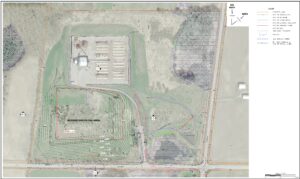 Their goals for CBSRS were to divert 500,000 m³ of excess soil from landfills to reduce environmental impact and save $4.3–$7.5 million in tipping fees to optimize municipal budgets. The project also had the potential to reduce transportation emissions by minimizing haul distances, targeting a 4.1 million km reduction and 4,395 tCO₂e savings. The transformation of the closed landfill was also an opportunity to improve the site’s landfill cap to reduce leachate and protect groundwater near provincially significant wetlands. A landfill cap minimizes the generation of leachate (contaminated liquid) by preventing surface and rainwater from infiltrating the waste and who doesn’t want that?
Their goals for CBSRS were to divert 500,000 m³ of excess soil from landfills to reduce environmental impact and save $4.3–$7.5 million in tipping fees to optimize municipal budgets. The project also had the potential to reduce transportation emissions by minimizing haul distances, targeting a 4.1 million km reduction and 4,395 tCO₂e savings. The transformation of the closed landfill was also an opportunity to improve the site’s landfill cap to reduce leachate and protect groundwater near provincially significant wetlands. A landfill cap minimizes the generation of leachate (contaminated liquid) by preventing surface and rainwater from infiltrating the waste and who doesn’t want that?
The moving of this mountain of soil would also create a scalable model for other municipalities to manage their excess soil sustainably.
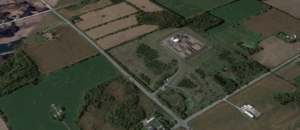 Prior to launching CBSRS, the Region of Peel conducted extensive research to ensure feasibility and compliance. The project team benchmarked existing soil management practices in Ontario, identifying that most municipalities relied on costly landfill disposal or distant reuse sites, leading to high emissions and inefficiencies. Consultations with the Ministry of the Environment, Conservation and Parks (MECP) confirmed alignment with Ontario Regulation 406/19, particularly its provisions for beneficial soil reuse. The team also studied closed landfill reuse models, finding few precedents for transforming such sites into soil management hubs.
Prior to launching CBSRS, the Region of Peel conducted extensive research to ensure feasibility and compliance. The project team benchmarked existing soil management practices in Ontario, identifying that most municipalities relied on costly landfill disposal or distant reuse sites, leading to high emissions and inefficiencies. Consultations with the Ministry of the Environment, Conservation and Parks (MECP) confirmed alignment with Ontario Regulation 406/19, particularly its provisions for beneficial soil reuse. The team also studied closed landfill reuse models, finding few precedents for transforming such sites into soil management hubs.
A site selection process identified the closed Chinguacousy landfill as the project site due to its dormant status and capacity for soil reuse. The development of a Fill Management Plan with AtkinsRealis, including Erosion and Sediment Control, Stormwater Runoff, and Traffic Impact Assessments to minimize community disruption. There was resistance from the Resident Liaison Committee and Town of Caledon regarding increased truck traffic and potential environmental impacts that proactive stakeholder engagement helped address.
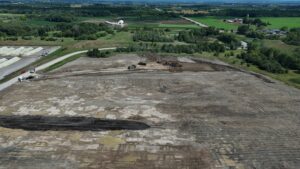
A geotechnical analysis, also conducted with AtkinsRealis, assessed the Chinguacousy landfill’s suitability for soil reuse, confirming its capacity for 500,000 m³ and compatibility with Table 3.1 Industrial/Commercial/Community (ICC) Excess Soil Quality Standards (ESQS). This less stringent standard allowed broader soil acceptance compared to typical Table 1 or 2.1 standards. Environmental assessments evaluated impacts on nearby wetlands, leading to the development of an Erosion and Sediment Control Plan and Stormwater Runoff Assessment. The research highlighted the potential for significant cost savings, emissions reductions.
The CBSRS team collaborated with internal teams (Waste Management Infrastructure, Transportation, Office of Climate Change and Energy Management) and external partners (MECP, Toronto and Region Conservation Authority (TRCA), Town of Caledon, Resident Liaison Committee) to ensure regulatory compliance and community buy-in. They also partnered with SoilFlo to implement digital tracking technology for real-time monitoring of soil deliveries, inspections, and reporting, enhancing efficiency and transparency.
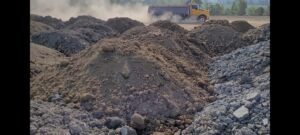 The landfill site was then prepared for soil importation, a process that included infrastructure upgrades to support truck traffic and environmental safeguards like stormwater management systems. In August of 2024 they initiated soil reuse operations—accepting Table 3.1 ICC-compliant soil for landfill cap improvement and future facility expansion. Monitoring of the site is ongoing. Metrics such as soil volumes (73,250 m³ reused by May 2025) cost savings ($546,000–$965,000), and emissions reductions (651 tCO₂e) are tracked using SoilFlo data and internal audits. Implementing SoilFlo’s digital tracking system required staff training and integration with existing municipal systems. While there was certainly a learning curve with SoilFlo, additional training sessions and a dedicated support team improved the overall process.
The landfill site was then prepared for soil importation, a process that included infrastructure upgrades to support truck traffic and environmental safeguards like stormwater management systems. In August of 2024 they initiated soil reuse operations—accepting Table 3.1 ICC-compliant soil for landfill cap improvement and future facility expansion. Monitoring of the site is ongoing. Metrics such as soil volumes (73,250 m³ reused by May 2025) cost savings ($546,000–$965,000), and emissions reductions (651 tCO₂e) are tracked using SoilFlo data and internal audits. Implementing SoilFlo’s digital tracking system required staff training and integration with existing municipal systems. While there was certainly a learning curve with SoilFlo, additional training sessions and a dedicated support team improved the overall process.
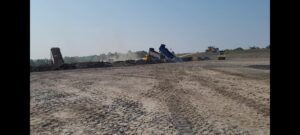 As of May 2025, 73,250 m³ of soil has been reused, with a capacity for 500,000 m³, reducing landfill dependency and improving the landfill cap to minimize leachate. That’s a saving of $546,000–$965,000 in tipping fee—with projected savings of $4.3–$7.5 million over the project’s lifespan, measured via financial audits comparing pre-CBSRS disposal costs.
As of May 2025, 73,250 m³ of soil has been reused, with a capacity for 500,000 m³, reducing landfill dependency and improving the landfill cap to minimize leachate. That’s a saving of $546,000–$965,000 in tipping fee—with projected savings of $4.3–$7.5 million over the project’s lifespan, measured via financial audits comparing pre-CBSRS disposal costs.
Transport has been reduced by 604,796 km, saving 651 tCO₂e, with a projected total of 4.1 million km and 4,395 tCO₂e, calculated using fuel consumption data and emission factors from the Office of Climate Change and Energy Management. As hoped and planned for, enhanced landfill cap protects groundwater near provincially significant wetlands,
Soil reuse and cost savings align with targets, and emissions reductions are progressing toward the 4,395 tCO₂e goal.
Not everything dirty is a secret. The project’s submission to the 2025 Excess Soils Symposium and transparent reporting inspire municipalities to adopt circular economy principles. CBSRS offers a replicable blueprint for municipalities, leveraging closed landfills, stakeholder collaboration, and digital tools, aligned with Regulation 406/19, enabling cost-effective and sustainable soil management across diverse contexts. You dig? If you do, you know how important this is.













